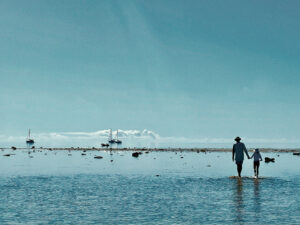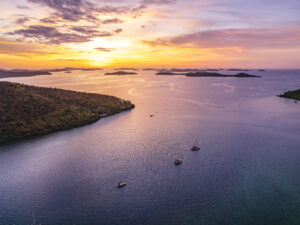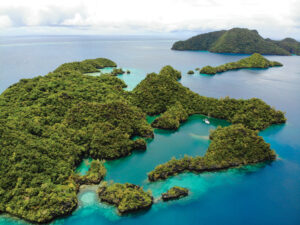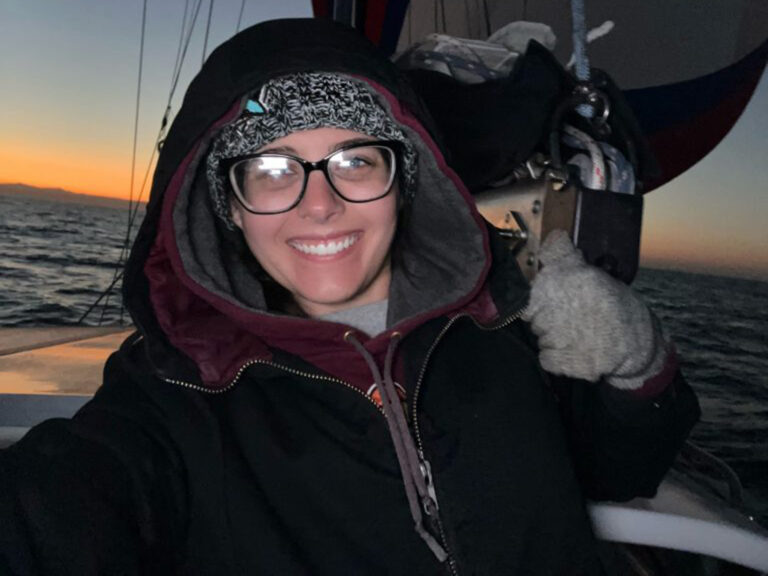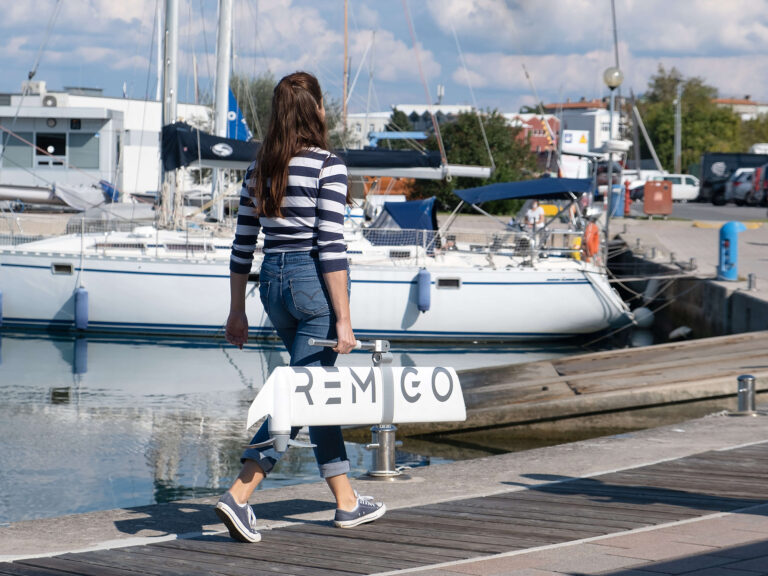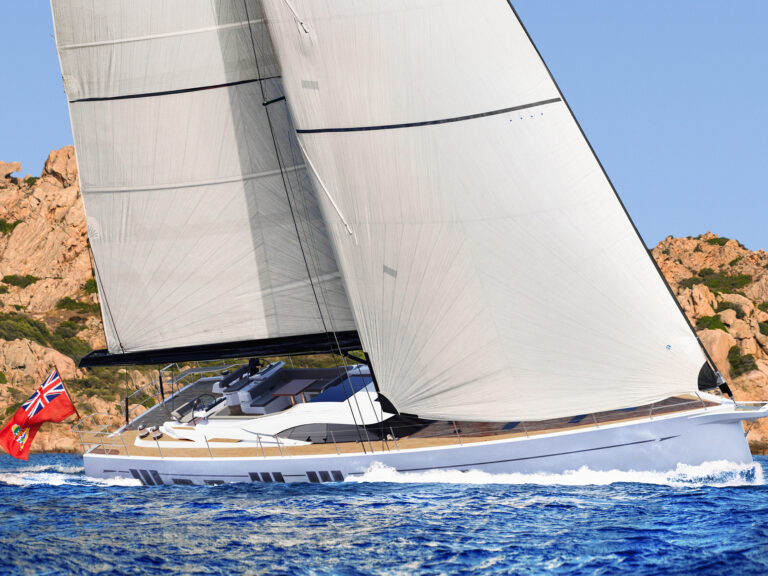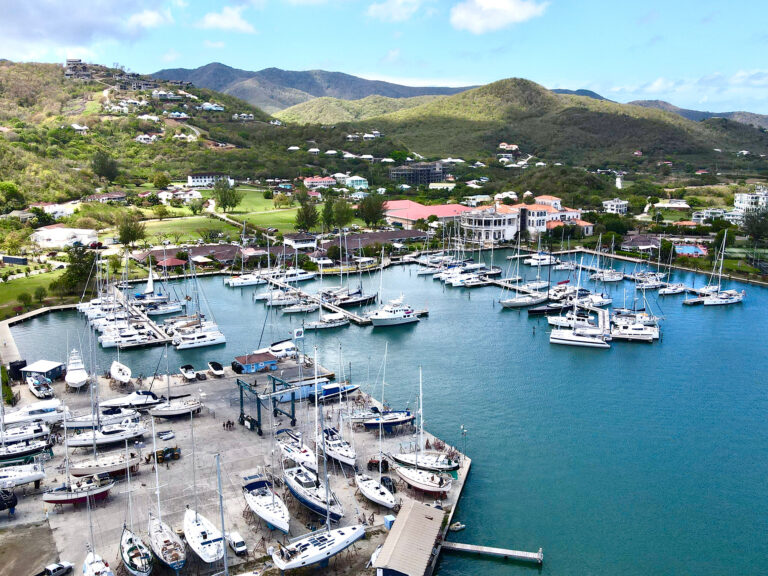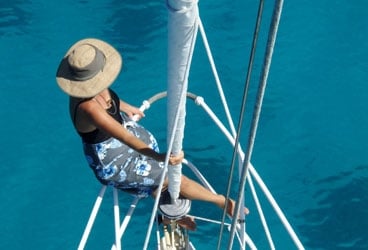
vanuatu simon 368
It’s the people. If I were to say nothing more, I’d have still expressed the essence of our experience in Vanuatu. When assessing a nation as a cruising destination, one must certainly include the white-sand beaches, the emerald-green jungles, the smoking volcanoes, and the coral gardens. And I will describe them soon.
I’ve found similar backdrops elsewhere, but never within the context of such a society. There’s something special happening here, something specific to this small cluster of islands and yet universal in its importance. It’s called happiness.
Admittedly, in Western terms, this nation is struggling in its attempt at modernization. This became apparent upon our approach from the Loyalty Islands, French holdings to the west of New Caledonia, to Port-Vila, the capital of Vanuatu on the island of Éfate. The country’s most important aide to navigation, the Pango Point Light, was extinguished. It was of little concern to us because Roger Henry, our 36-foot steel cutter, had ripped off 200-plus miles in 30 boisterous hours, making for a perfectly timed dawn landfall.
We anchored in the designated quarantine area and by VHF notified the bureaucracies of our arrival. After two hours without a visit, Diana decided it was safe to take a bath in the cockpit. She was no sooner soaped up than a boat buzzed alongside, and without so much as a by-your-leave, several uniformed men jumped aboard, catching her in all her splendor. Had there not been a trail of bubbles leading below, I would’ve sworn she disappeared into thin air.
You couldn’t call Port-Vila pretty. It’s a dusty, run-down town, yet it’s surprisingly charming. That’s due to the atmosphere on the streets, one of vibrancy and contentedness. Everyone has a warm smile for you. I believe it’s a convergence of several factors. For one thing, Vanuatu, which had been administered since 1906 under an arrangement called the Anglo-French New Hebrides Condominium, won its independence from France and Britain in 1980, an achievement delayed long enough for the people to have developed a keen longing for self-determination yet a struggle not so prolonged that the people experienced protracted conflict and inherited a bitter legacy.
Next, the island is so lush that it amply supports the slim population of 210,000. Virtually every citizen is assured of access to a productive garden of fruits and vegetables and a fishing spot.
Also, the citizens have one foot planted in a reaffirming past that’s reinforced via a cohesive system of tribal affiliation; the other foot is planted in a democratic future with an informed, enthusiastic, and active citizenry.
I don’t mean to romanticize the lives of the ni-Vanuatu, for there remain issues surrounding health, education, and economic opportunity. Nor do I mean to evoke Rousseau’s sentiments of the noble savage. Recently, a prime minister was caught with his lava-lava down, counterfeiting the local equivalent of $23 million. He was jailed briefly, but after the usual “Let the healing begin” pronouncements, he was pardoned by his handpicked successor. So you see, they’re learning Western ways. But they’re a free people, shaping their own destiny, and clearly happy to be doing so.
Yachting World in Port-Vila offers moorings in the central harbor at a reasonable rate as well as fuel, water, rubbish disposal, a secure dinghy dock, and a classy waterfront restaurant. Vanuatu beef is reputed to be the finest in the world, and I won’t dispute that. A local brewery produces quite a quaffable beer served at a temperature to tame the tropics. Each night a stunningly talented band plays beneath a thatched pagoda.
The bustling open market of Port-Vila is a colorful hub of daily life. Flowers, firewood, and an amazing array of fruits and vegetables are trucked daily from the outlying regions. Wild-looking vendors hawk coconut crabs, penned pigs, caged chickens, and fried fish. Down an alley of plywood stalls, Diana and I sampled foods totally unrecognizable to us.
In her enthusiastic pursuit of local weaving, basketry, and art, Diana discovered artist and activist Juliette Pita. Despite her growing international reputation, Juliette appears barefoot daily in her little stall on the waterfront, where she sells tapestries depicting her unique interpretations of kastom, or traditional, dancing. As one of the founders of the Nawita Association of Contemporary Artists, Vanuatu’s first contemporary artists group, she carries on her work of promoting women’s rights and eradicating domestic violence with a humble, yet determined, nature.
As we mingled with the locals, we realized that Melanesians are an attractive people. The men are well proportioned and heavily muscled. I have always been a fool for a pretty face; and my goodness, the girls here are easy to look at.
For some cruisers, the Vanuatu experience begins and ends in Port-Vila. And you can’t blame them-it’s seductive, lovely, and lazy. But we had come to see the wilder side of the fabled former New Hebrides, so named by Captain James Cook in 1774. Cook was by no means the first European to set foot here. It’s believed that Pedro Fernandes de Queiros was the first, with his 1606 landing at Espiritu Santo, the largest of the more than 80 islands.
The first missionaries arrived in 1839. They were promptly killed and eaten. This discouraging trend slowed the rate of so-called progress, but it ultimately didn’t deter the invasion of sandalwood profiteers and colonizing powers. As a rare example of Anglo-Franco cooperation, Vanuatu was run under the Condominium between those two nations right up to its independence.
As a boy, I wore out the issue of National Geographic that pictured young men of Pentecost island hurling themselves off a rudely constructed tower of bamboo and vines. Their head-down plunges toward the ground were arrested only by a jungle vine tied to their ankles. If the old shaman who cut the vine had calculated its length, its stretch, and the height of the tower and boy correctly, the diver’s head hit the soil firmly but without injury, and the boy gained entrance into manhood. If not, well, the gods have spoken.
I’d burned in envy at the exotic daring of it all, and I even tried to sail here almost 30 years ago in the hopes that they might allow a dim-dim (meaning “white man” in Bislama, Vanuatu’s English-based pidgin) to join them in their sacred ceremony. Cyclone Fredrick thwarted those plans, but I still hoped to witness some of the old customs of a life that’s too soon to vanish from this world.
A mile from Port-Vila, the paved roads turn to mud, the electric lights to kerosene lamps, and the automobile traffic to the soft cadence of human footfalls. The veneer of a modern western civilization peeled away with every mile that we sailed north.
Balmy breezes carried us into Havannah Harbour, on the northwest side of Éfate. The thatched housing in the main village indicates a simplicity of life; the paths are swept clean, the yards are orderly, and a sense of pride prevails.
Through a complex and sometimes confusing system, every tree, coconut, stretch of reef, and body of water has an owner. Should we want to anchor, dive, hike, or fish, it was our responsibility to ferret out the correct owner and request permission to do so. Despite being with three local guides while diving on a reef, I was dressed down by an elder for not having specific permission from the correct chief.
However, once we established a pattern of promptly presenting ourselves, gifts in hand, to anyone even pretending to be a local chief, we were never denied a thing. In fact, yachts are welcomed as the sole source of income in many of the outlying islands. Cash aside, even the most pedestrian of our throwaway items-a plastic bottle, old clothes, a rusted fish hook or file-are treasured.
To see a lovely family paddle by with their clothes falling off their backs is heartbreaking. The sailing community has responded generously, as most boats arrive packed to the gunwales with bundles of clothing, school supplies, and fishing gear to distribute. Old salts are constantly lamenting the changes in the number and nature of cruisers today. The days of lonely anchorages and trading old T-shirts for valuable artifacts may be gone, but the affluence and attitude of the modern fleet has been a blessing for this small nation.
Along with food, medicine, and a few mechanical skills, I decided the most valuable thing we could offer was respect-that is, to take a sincere and personal interest in the people we met and express that with a simple invitation to board our boat and home.
In anchorages that had seen hundreds of sailboats, almost every family we invited onto Roger Henry told me that they’d never been on, much less in, a yacht before. Their entire intercourse with their visitors had been from a canoe-level perspective looking up.
I handed out pounds of treats to the children, and Diana must have prepared a thousand cups of coffee for the adults. Roger Henry’s interior was a marvel and a mystery to child and adult alike. We think of our boat as a modest yacht, but it electrified these people to see the complex systems of a small city in operation: propulsion, water stowage, electrical generation, waste disposal, food preparation, mechanical workshops.
For the children, the galley foot pump was a big hit. They could’ve seen the entire South Pacific Ocean gush through that pump and still not have lost those amazed smiles.
But the real sensation was Halifax of the North. No one had ever seen such a big cat. When she came thundering up the companionway, a 200-pound man asked me if it was safe to come on board. Once visitors were assured of her gentle nature, I thought they’d pet the fur right off her. When I told them the story of how she once saved my life as an infallible polar-bear detector, her legend only grew. As we walked through villages, I could hear her name being whispered in our wake.
Meandering north, we stopped in Revolieu Bay, at the island of Epi. A freshwater river dams up just behind the beach, forming a deep jungle pool. Now Diana will tell you of the time she watched Nureyev dance in London, but down deep she’s still a farm girl who appreciates the basic necessities-such as fresh water, lots of fresh water, a commodity I’ve denied her through these many years on board. She enlisted me in a major laundry effort that included bedding, clothing, cushions, and bodies. I lost much face with the local men, who clearly consider this a “pink” job.
Chief John invited the crews of the three yachts anchored in the bay to his home for a feast. For all but the pig, it was a wonderful experience. Wild pork and cassava bathed in coconut milk were wrapped in banana leaves and baked to perfection in the ground.
Why is there war when men and women worldwide are so alike? After the banana leaves were cleared away, a big smile swept the men’s circle when John suggested a little drink. Kava, a drink once reserved for chiefs, is now as ubiquitous as an American’s cold beer after a hard day’s work. From Fiji west through Vanuatu and up into the eastern Solomon Islands, kava is the drink (or drug) of choice, and it plays a major role in the daily lives of the men.
John diced the rough root with a machete, ground the pieces into a pulp, then mixed it with water. The slurry was squeezed through a cloth several times, and the pulp was discarded. The remaining liquid was a muddy astringent drink that’s best described as an acquired taste. Its effects are easier to get used to. It’s a soporific that puts the men in a contemplative mood, gilded with a sense of mild euphoria.
At each island, I was asked if I’d ever tried kava before. When I said, “Yes, at the last island,” they’d dismiss that with a wave. “No, no. That’s not real kava. They make it too weak there. Now, our kava! Four cups and a man can’t find his way home!” Diana intervened before I could test that assertion.
There is some concern regarding the effects of kava on the liver. However, kava doesn’t incite the aggressive behavior of alcohol, and because it grows so prolifically, the men don’t feed their habit at the expense of the meager family budget.
At the northern end of Epi, we stopped in Lamen Bay to swim with the dugongs. North of Epi, the island chain splits in two. To tack west for Malakula and Espiritu Santo meant missing Pentecost and Maewo to the east. After a difficult deliberation, we set sail for Malakula, attracted to its geographic, cultural, and linguistic diversity.
Vanuatu has the world’s largest number of languages per capita; on Malakula alone, 28 are spoken. The island is best known for two tribes: the Big Nambas and the Little Nambas, so distinguished by the differing size of the namba, the traditional penis sheaths worn by the men. Both tribes still cling fiercely to their traditional ways.
After a week of snorkeling in the Maskelynes Islands at Malakula’s southern tip, we beam-reached up to Banam Bay to find five yachts anchored there. Our arrival must have created a critical mass because the chief announced that the village would present a traditional dance for our benefit and their profit.
We gathered at the sacred dancing circle and a hush settled over us. Suddenly, 20 armed men rushed out of the bush dressed-if you can call it that-only in leaves tied around their, well, nambas. These sheathes were held up at a proud angle by sennit running from the tip around the men’s waist. Frightening masks and tall hats added to the exotic atmosphere. Drums and ankle bracelets set the spirited rhythms that accompanied the war, fertility, birth, circumcision, and burial dances. The women, dressed only in grass skirts, followed with quieter dancing and harmonious singing.
I have no quarrel with these people charging a modest fee for viewing their traditional ceremonies. It might be viewed as a renewable resource that bridges their strong connection to the past with the demands of a fast-changing, cash-oriented future. But when reports came in saying that in bays to the north, surly youths were charging yacht crews for simply landing on a beach, we decided to leapfrog northern Malakula and make for the nation’s second largest town, Luganville, on Espiritu Santo.
We set up camp at the Aore Island Resort, on the islet of Aore, separated from Santo by the mile-wide Segond Channel. It was pure luxury being able to catch the resort ferry to the hot and dusty town for provisioning, fuel, and repairs yet retreat to the idyllic atmosphere of the resort by evening.
Here we said our good-byes to the yachts we’d befriended coming north, for without exception they were all heading west to Australia or south to New Zealand for the cyclone season. This meant that we’d have the islands north of Santo all to ourselves, a prospect I relished.
An exhilarating dive deep into the bowels of the sunken SS President Coolidge, an enormous World War II-era wreck, was the highlight of my stay in Luganville. Despite the amenities of civilization, I had no regrets when we headed out for the remote Banks and Torres islands.
Southeast trade winds pushed us up the coast of Santo and determined which bays were tenable anchorages. Once through the narrow entrance, we found Port Peterson sufficiently scenic and snug enough to be considered a true hurricane hole. We took the dinghy up a jungle river, searching for a blue hole noted on the chart. As the stream narrowed, water lilies blocked our way. But in a river a mile to the south, we found a spectacular blue hole that was surrounded by steep cliffs, lush jungle, and raucous birdlife. We swam for hours in the bottomless blue water, then floated home quietly, clean and refreshed.
Our experience in each of the high jungle islands to the north was largely determined by the personality of the chief. In the village of Losalava, on Santa Maria in the Banks Islands, the chief monopolized our time and gift giving. In the less traditional regional capital, Sola, on Vanua Lava, we were free to mingle and form friendships more naturally.
In all the islands, however, we were awed by the scenery, impressed with the thatched villages, and forever touched by the warm reception.
The national government has all but abandoned the people up here. The clinics are poorly staffed and stocked, and the international aid seems to dry up long before projects can be completed. The schools charge the equivalent of US$600 per child per year. This places an enormous pressure on families always starved for cash. The churches have stepped in where the government has failed, and although they have a reputation as cultural imperialists, they now provide many of the essential services.
This is a land on fire. We sailed past a string of smoking volcanoes, ominously glowing orange in the night. When Ureparapara blew hundreds of thousands of years ago, it created a hole in the crater wall, and seawater flooded in. We passed through the narrow passage that formed, then anchored right in the bowels of the now-extinct volcano.
In the Torres Islands, we walked down beaches so white we had to shade our eyes. We dove on rich coral gardens through clouds of fat fish. We sailed through water so clear that I thought we were running up on shoal ground until the depth sounder confirmed that we were in 60 feet.
Perhaps it was fitting that the last people we met in Vanuatu were Johnnie; his wife, Lea; and three beautiful children, a pioneer family barely scratching out a living on the west coast of the Torres Island of Tegua. Their worldly possessions wouldn’t have filled our dinghy, and yet they kept offering us gifts. They sadly waved good-bye from the beach as we set sail north for the Solomon Islands.
We spent three months energetically exploring this verdant nation. Nevertheless, we feel that we barely tapped its potential. But this we did do: We reassessed our own lives and saw how relatively wealthy we are. On that topic of wealth, we learned how to differentiate poorness from poverty, for the people of Vanuatu are poor but not impoverished in spirit. These people, who want for so much yet long for so little, have found an affirming sense of place. They lead humble lives in harmony with nature. They do so happily, emotionally anchored to each other, spiritually connected to the past, and hopeful of a meaningful future.
Alvah, the author of North to the Night, and Diana Simon are co-recipients of CW’s Medal for Outstanding Seamanship. Keep up with the Simons, who are cruising in the Aleutian Islands on board Roger Henry, via Alvah’s blog at CW’s website (www.cruisingworld.com).
Vanuatu at a Glance
Currency: Vanuatu’s unit of currency is the vatu; approximately 90 vatu equal US$1.
Ports of entry: Vanuatu’s ports of entry are Lenakel (on Tanna), Port-Vila (Éfate), Luganville (Espiritu Santo), and Sola (on Vanua Lava, in the Banks Islands).
Visas: Sailors upon arrival must obtain a visa for 30 days; it can be extended to four months. Cruising permits cost 7,000 vatu, plus 100 vatu per day in country. Additional fees are levied for immigration and quarantine clearance, extensions, and crew change, among other things.
Climate: Vanuatu’s wet season runs from November to April; the dry season extends from May to October. The climate is subtropical to tropical.
Prevailing winds: The southeast trade winds dominate.
Cruising season: The cruising season in Vanuatu runs from May to November.
People: Vanuatu’s inhabitants are 98 percent Melanesian; Europeans, Vietnamese, Chinese, and other Pacific Islanders make up the rest.
Language: The ni-Vanuatu speak English, French, Bislama (the English-based pidgin used throughout the archipelago), and numerous local dialects.
Geography: The country consists of 12 principal islands and 71 smaller ones. The islands have fringing reefs but no lagoons. Anchorages are limited. Vanuatu, part of the long chain of volcanic islands called the New Hebrides Arc, contains some of the world’s most active volcanoes.
Resources: Yacht Miz Mae’s Guide to Vanuatu by Nicola Rhind ($25; 2nd ed.; www.armchairsailorseattle.com) contains accurate in-depth information for every major island and anchorage. Nautical Rocket Guide to Vanuatu ($99; www.Cruising-Vanuatu.com), a cruising guide on CD-ROM produced by Richard Chesher and Frederique Lesne, is an essential tool for anyone planning to visit this country. Lonely Planet’s Vanuatu and New Caledonia Travel Guide by Jocelyn Harewood, Tione Chinula, and Vincent Talbot (2006; $17.50; www.lonelyplanet.com) is a travel guide that’s comprehensive, usually accurate, and always interesting. For more details about marina and yacht club services utilized by the crew of Roger Henry, consult the CW website (www.cruisingworld.
com/0902simonvanuatu).

